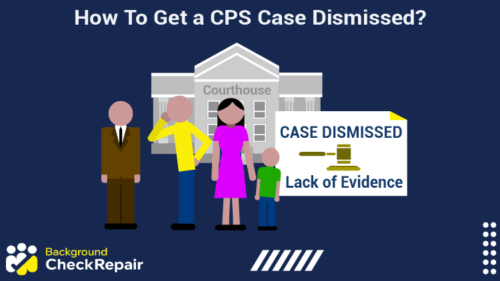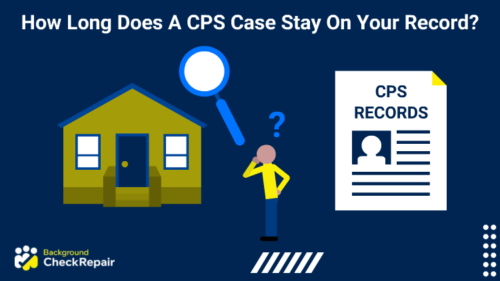
Parents facing an unwarranted investigation often wonder how to get a CPS case dismissed in California?
The first step is to understand what California law allows CPS to legally do and the procedures that are implemented when a report of abuse or neglect of a child is filed.
In order to have the best chance of fighting a CPS case and keeping custody of your children, parents must understand how the investigative process operates, and be prepared.
Because in many states, like California, this government agency may physically take your child without your knowledge, even though nearly half the CPS investigations filed result in no evidence of abuse or neglect.
This guide outlines the legal methods parents can use to learn how to get a CPS case dismissed in California.
How To Get a CPS Case Dismissed in California
When asking how to get a CPS case dismissed in California, individuals should know that there are numerous ways to achieve this result.
However, parents and grandparents should learn the way CPS works in order to identify what their best chance is of having the case dismissed.
The first step is to consult an attorney or family practice lawyer. There are also nationwide agencies that specifically provide legal counsel for parents who are trying to fight a CPS investigation.
Having legal representation, as well as character witnesses can help move the process along quicker.
Recent federal laws require states to make “reasonable efforts” to restore children to their parents. This means that performing the requirements requested by a CPS worker can also help get the case dismissed.
CPS Case Procedure: How To Get a CPS Case Dismissed in California
Part of the confusion over the way a CPS case works is the use of the word ‘case,’ when the word ‘investigation’ is slightly more accurate.
Many people believe that CPS cases will always involve the courts and that when a case has been opened charges will be filed. However, this is not the case.
When CPS receives a tip that prompts them to open an investigation, they will simply begin looking for evidence of abuse and neglect. This will often involve CPS agents visiting the home, and talking directly to the parent who is responsible for the well-being of the child.
It will also include speaking to the child, without the parent’s consent, as well as interviewing the individual who made the report and talking with anyone else that might have knowledge of what kind of behavior is occurring in the household.
The investigation also often includes a physical inspection of the household itself.
If the agency worker observes evidence of abuse or neglect, the CPS caseworker will likely get the courts involved and the parent will be asked to appear in front of a judge to explain the situation. During this time CPS may also work with the parent to come up with possible solutions.
This is more common in cases of neglect in which the parents are given a chance to reform and meet the standards set by CPS. If the individual does not make these changes, CPS will likely recommend to the judge that custody rights are taken and the child be removed from the home.
Although CPS can make recommendations, in most situations it will be technically up to the judge to decide if custody rights should be taken away if there is evidence of severe abuse or neglect.
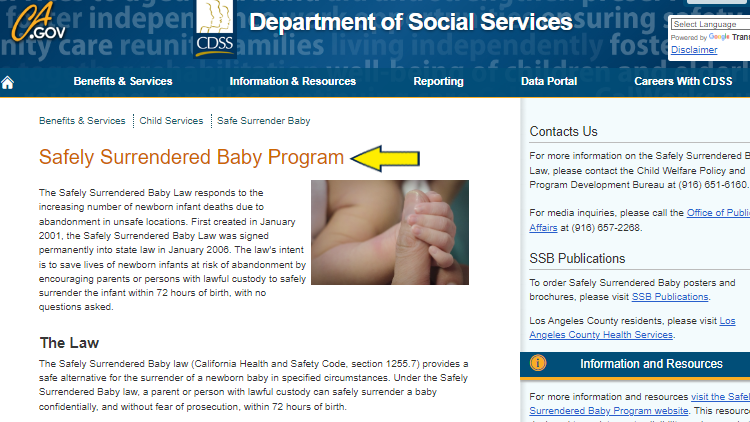
The California Department of Social Services offers many programs designed to protect the welfare of children, including a safely surrender baby program allows parents to surrender a baby within 72 hours, without any questions.
Besides the procedure itself, those trying to figure out how to get a CPS case dismissed in California should also familiarize themselves with their local laws, specifically the definitions of child abuse and neglect,7 as well as the definitions of domestic violence and things like infant safe haven laws.3,8
By understanding the legal definition of these terms in California, individuals can get a better understanding of what CPS is looking for and what might stand out to the CPS caseworker as a red flag.
For example, child witnesses to domestic violence can be seen as neglect, even if the child was not directly involved.9
Understanding these terms will also help individuals to understand what is likely to happen to their children should the case not end in their favor.
How To Get a CPS Case Dismissed
When it comes to how to get a CPS case dismissed, there generally two options.
Cases that are ‘dropped’ before the courts get involved, and cases in which the case is formally dismissed once court proceedings have already begun.
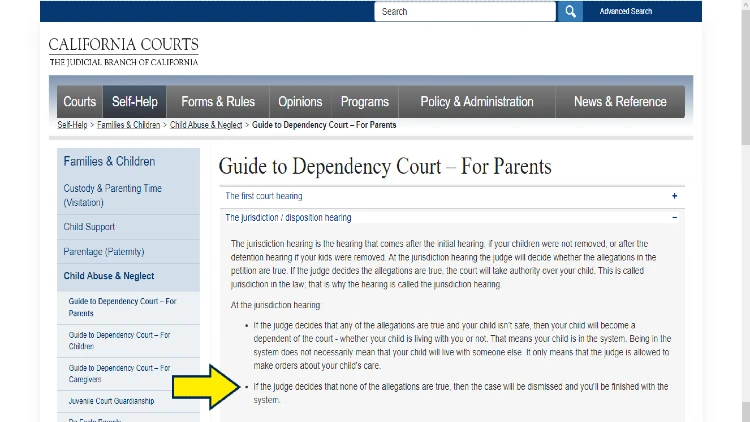
Dependency Court hearings determine whether or not a child is safe with their parents.
In general, it is far better to get a case dropped earlier rather than later, to avoid legal fees and to prevent the process from taking months to complete.
Getting a Case Dismissed Before Court
The best thing that individuals can do for themselves when they find out they are under investigation by CPS is to hire a lawyer immediately.
An experienced family law attorney will be able to guide individuals through the state’s process as well as give them advice on how to handle various situations in order to have the best chance of having the case dropped, or at the very least, the best chance of keeping custody of their children.
When trying to have an investigation dropped before the courts get involved, there is a strong possibility that simply cooperating with the CPS caseworker will be effective. Those wondering how to get a CPS case dismissed fast will likely want to simply prove that there is no abuse or neglect occurring.
CPS case statistics show that more than half of CPS cases are closed simply due to there being no evidence that abuse or neglect has occurred.10
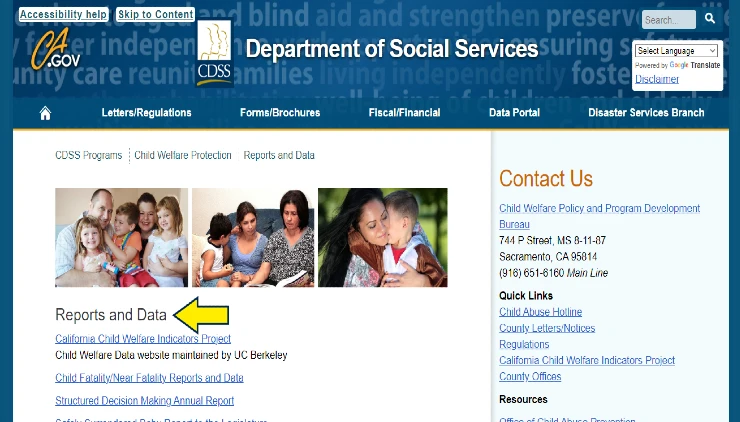
The Department of Social Services provides reports and data about CPS activities, maintained by UC Berkeley.
If the CPS caseworker finds any evidence of abuse or neglect, they will likely get the courts involved at which point the situation can become far more difficult to remedy.
Keep in mind that CPS will often give individuals a chance to fix certain things in the home. This can be a great way to get the case dropped as CPS can drop a case at any time if there is no evidence of abuse or neglect.
Although CPS can not get a court order to enforce these instructions, failing to follow CPS instructions can result in the CPS worker explaining to a judge that the parent failed to cooperate.
Getting a Case Dismissed in Court
Trying to get a CPS case dismissed once the courts are involved is far more difficult and will require that the individual or their lawyer file a formal motion to dismiss. This motion will be considered by the judge using the reasons provided for why the case should be dismissed.
There are numerous reasons why a judge may choose to dismiss a case but the majority will be dismissed due to procedural issues or lack of evidence.
Procedural issues will generally involve the CPS caseworker not following proper protocol or breaking the law in some way during their investigation. This is why it is so important to know the laws and what CPS is allowed to do, which is discussed further down.
Lack of evidence is also a common reason for a case to be dismissed, however, this is fairly difficult. If the CPS caseworker has already brought the case before a judge, they likely already have evidence of neglect or abuse which the individual will need to disprove in order to have any chance of the judge dismissing the case.
What Is CPS?
Child Protective Services is an agency in every state that is generally a part of the state’s division of childhood and families or an equivalent agency.1
In California, CPS is a division of the California Department of Social Services.2 Although the agency has federal laws that must be followed at a minimum they will also have various state laws they will need to follow as well when it comes to their investigations.
The main role of CPS is to ensure that children are in safe environments with reasonable accommodations. This includes things like basic hygiene, ensuring they are not victims of family violence or physical abuse,3 and that their parents or guardians are meeting basic education requirements that are mandated by state law.

Mandatory reporters are professionals such as educators, medical staff, and child care providers, and the law requires them to contact CPS if abuse or neglect is suspected.
CPS relies largely on reports of abuse and neglect from individuals when it comes to their investigations. Although in many cases these reports of abuse or neglect will be made by another family member, the majority of these reports come from mandatory reporters.4
A mandatory reporter is someone who holds a specific position that is required by state law to report potential abuse and neglect to child protective services.5
The most well-known example of this is teachers, however social workers, doctors, school administrators, and mental health professionals are all required by law to make reports. If a report of abuse or neglect is made that CPS deems to be credible, they will open a case on the matter.6
CPS Background Check
Even if a CPS case is dropped, many individuals will be worried about the long-term effects and will have questions like, how long does a CPS case remain on your record?
CPS cases that are dismissed or dropped should not appear on an individual’s record.
This information would only appear on the parent’s record if criminal charges were filed against the individual, in which case it would be one of the things on the list of what is included on a background check for employment.
Many of these fears stem from individuals hearing about a CPS background check and worrying they will appear in any database. However, the CPS background check is also referred to as a foster parent background check or as child protection and abuse background checks.
All of these checks are the same thing and refer to the federally mandated background check that must be performed on individuals that work with children such as the teaching positions, background checks for daycares, and foster parents background check.11
Individuals who are still concerned should learn how to obtain a criminal background check on themselves using the search bar at the top of this page.
What CPS Can and Cannot Do: California
State law prohibits certain actions by both parents and CPS investigators in California.
When it comes to what CPS can and cannot do in California, there are only a few practices that individuals should be aware of.
What CPS Can Do in California?
- Remove children from the home with a court order
- Take away parental rights with a court order
- Speak with your children without permission
- Show up at your home without notice
The most important thing to note is that in order to remove children from a home, CPS will need a court order. However, this will often happen suddenly and the children can be removed without notice in many cases to prevent parents from fleeing with their children.
In regards to speaking with your children without permission, this is done so that children are not coached by the parents on what to say to CPS workers.
Finally, although they can show up at your home without notice, they can not enter without your permission.
What CPS Can Not Do in California?
- Forcibly enter a home without permission
- Force an individual to take a drug test
As mentioned, CPS will need permission or a court order to enter someone’s home that they are investigating. Although drug use can be seen as a sign of neglect, CPS can only force individuals to take a drug test with a court order.
Does CPS Notify the Other Parent?
Something that many individuals are concerned with is, does CPS notify the other parent, which they often do.
However, this is only done if the other parent is involved or has partial custody of the child because CPS prioritizes the placement of children with relatives.
This is part of California state law which requires reasonable efforts to preserve or reunify families and achieve permanency for children.12
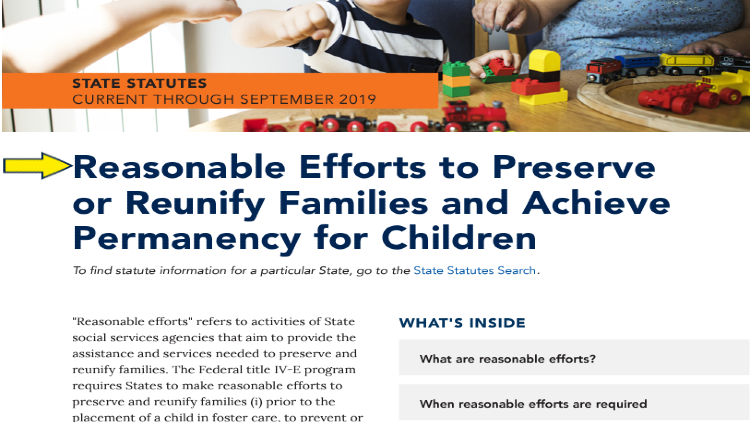
Reasonable efforts to keep families together is required by federal law, but each state follows its own guidelines.
If the child is being removed from the home and another parent is not able to take them in, the state will then pursue standby guardianship for the duration of the investigation.13
Does CPS Have To Notify the Other Parent in California?
So, does CPS have to notify the other parent? Usually no.
The only time CPS will notify the other parent is if the custody is involved in which case the child will likely be transferred to this other parent for the duration of the investigation and possibly longer.
CPS Non-Custodial Parent
The term non-custodial parent can be a bit confusing in CPS cases.
The non-custodial parent is simply the parent that does not have primary custody of the child, although they may have partial custody or visitation rights.
Non-Offending Parent in CPS Case
The non-offending parent in CPS case can also play a major role.
The non-offending parent is simply the parent who is not under investigation. However, they will still likely be in contact with the CPS case worker if they have custody of the child.
Rights of the Non-Offending Parent and Non-Offending Parent Evaluation
The rights of the non-offending parent in a CPS case are fairly straightforward. They have a right to appear at any court hearings to ask questions, provide evidence, and provide testimony in the case.
In many cases, the non-offending parent can have a huge impact on the outcome.
The non-offending parent evaluation is what occurs when custody of the child needs to be transferred permanently or temporarily.
The evaluation is simply to ensure that their non-offending parent can reasonably provide for the child.
Grounds for Involuntary Termination of Parental Rights
The grounds for involuntary termination of parental rights will vary from state to state.14 In most cases, it will be due to severe forms of abuse and neglect such as physical abuse, sexual abuse, abandonment, and other serious abuses.
In most cases, it is extremely difficult for parents to regain their parental rights after having them terminated.
Facing a CPS investigation is many people’s worst nightmare, however, it is not the time to panic.
By understanding local laws and getting an attorney as soon as possible individuals wondering how to get a CPS case dismissed in California will have a very good chance of keeping custody of their children.
Frequently Asked Questions About How To Get a CPS Case Dismissed in California








